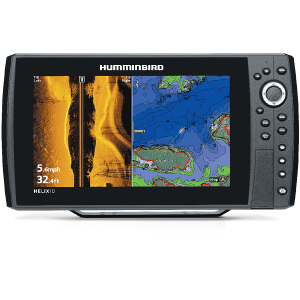Best Fish Finder: A Complete Review and Buying Guide 2018
Table Of Contents
Best Fish Finder Complete Review
Introduction
With the advent of technology, you’ll find many different gadgets that will help you find fish. There are many good fish finders available on the market to make your fishing experience better and easier. A fish finder gives you the exact location of fish in the water. It is also known as the fish sounder. This is because it works on the mechanism of sound detection.
Fish finders can be a useful tool whether you’re a seasoned professional or a novice angler. While they may seem a bit overwhelming the first time you use one, fish finders are actually pretty easy to use once you get the hang of it.
Essentially, fish finders use sound waves to determine the depth of the water and give you further information about what (if any) fish are present. There are a large variety of fish finders (or sounders, as they’re known down under) to choose from, so finding the one that best meets your needs isn’t going to be too difficult once you learn a little more about them.
Factors to Consider Before Buying a Fish Finder
Sonar Strength

Sonar Strength is important
The most important thing to consider when buying a fish finder is the type of water you’re fishing in. For instance, the fish finder you ultimately choose needs to have a sonar powerful enough to reach the bottom as well as being able to pick up structures that lie in the deep as well. If you’re fishing in small freshwater lakes and rivers, your needs are pretty straightforward. But for those fishing the coast or in deep, freshwater lakes, you’re going to need a sonar that is capable of mapping the underwater terrain in your fishing area.
Likewise, the sonar needs to be powerful enough to pick up the fish you’re targeting. While pros and intermediate anglers are aware of this issue, many novices forget that different fish prefer different underwater habitats; simply put: some fish swim deeper than others. If you’re targeting a fish that swims near the bottom of the ocean floor, then you’re going to need a sonar that can visualize that area and the fish that swim in it accurately.
You might say that the deeper the water, the more powerful your sonar needs to be and the more robust the features your fish finder comes with need to be in general.
Number of Views
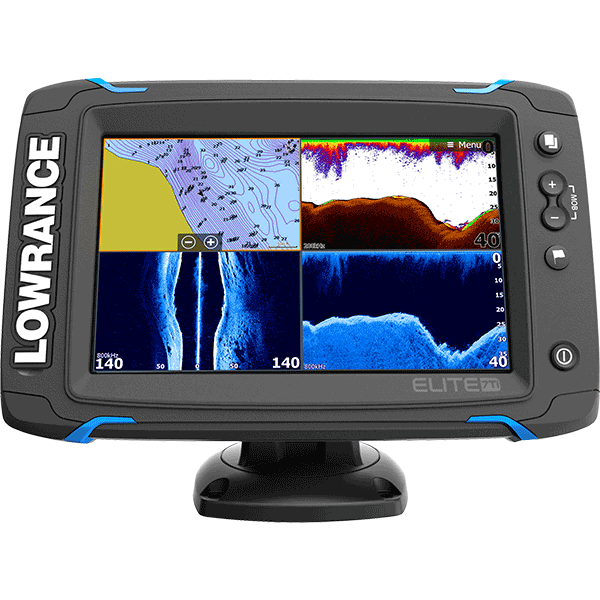
Example: 4 Windows View
On that note, many fish finders offer more than one view than standard sonar. For instance, they may offer near-photographic HD sonar as well as contour maps. Most of today’s fish finders have a multi-windowed mode where you can view two or more of these views at the same time. This is great for intermediate and advanced anglers who are looking for very specific and up-to-the-minute information. But the novice won’t miss out by having these advanced features at their fingertips. On the contrary, it can give those new to fish finders a way to compare the data they’re seeing and learn about it on the job, while they’re actually using the device.
Network Support
Many fish finders come with ethernet built-in. Some may even have built-in wi-fi. Take this into consideration if it’s at all important to you, as some, even in 2017, still don’t have these features. But for those that do, you get a lot of extra utility, such as automatic contour map creation or enabling you yourself to create your own contour maps on the go. Sometimes fish finder makers will have their own apps where you can upload sonar imagery for later review—or even share on social media, making it a great option for fishermen who like sharing with their friends or helping out newer anglers.
GPS
Built-in GPS is a key feature that a lot of people overlook. It can be very handy, though, because it’s another element that enables map creation, so look for that as well.
Screens Brightness
Screens are important, though they often take the backseat to the techier features. But consider this: You’re out in the water on a bright sunny day. The sunlight and the sunrays bouncing off the water are really a detriment to your fish finder viewing capabilities. For this reason, it’s a good idea to consider display screens that feature backlit LED technology. Backlit LED has less image distortion than other forms of LED. Plus, it also has greater light/dark contrast, and the colors “pop” more. All of this enables you to see a lot better on bright days, so you don’t miss the fish you’re targeting.
Top 10 Best Fish Finders
| Lowrance Hook 7 | Lowrance ELITE-7 Ti | Lowrance HDS-7 GEN3 | |
|---|---|---|---|
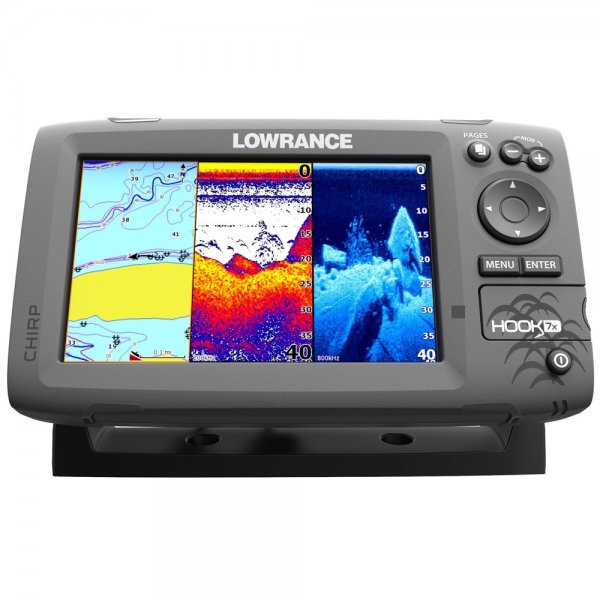 |
 |
 |
|
| Rating | ★★★★★ | ★★★★★ | ★★★★ |
| Screen | 7" (800×480) | 7" (800×480) | 7" (800×480) |
| Sonar | 83/200kHz | (50/200 or 83/200 kHz) + 455/800 kHz | 83/200kHz |
| Chirp | |||
| GPS | |||
| Micro SD | |||
| Price | $$$$ | $$$$ | $$$$$ |
| Check on Amazon | Check on Amazon | Check on Amazon |
Lowrance Hook 7

The Lowrance Hook 7 features an impressive 7-inch high resolution color display that allows for easy viewing of the vital details you need to know, all of which are available at a glance, thanks to the multi-window display, which allows you to choose the handy three-panel view and other presets. This way, you get the info you want all in one place, without having to swap to other views. CHIRP Sonar and DownScan work together to provide the ultimate sonar view for your fish finding needs.
Advanced Signal Processing (ASP) simplifies the viewing process, reducing how often you need to manually adjust to get the best view, allowing you to better focus on the task at hand.
Lowrance Hook 7 Complete Review
Lowrance ELITE-7 Ti

The Lowrance ELITE-7 Ti uses DownScan imaging and CHIRP sonar to provide the best possible view below your ship.The ELITE-7 Ti features a unique, 7-inch touchscreen that makes navigation through different views a piece of cake. Meanwhile, the LED backlighting on the screen allows for greater contrast so even on bright, sunny days you can still get a clear view of what’s going on beneath the water.
Key features include being able to scroll through previous sonar images and a GPS antenna for extra utility.
Lowrance ELITE-7 Ti Complete Review
Lowrance HDS7 GEN3
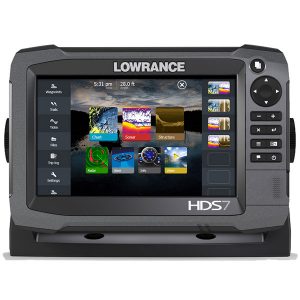
The Lowrance HDS7 GEN3 features both an easy-to-use 7-inch touchscreen display as well as a keypad, so you can interface with the fish finder is the way that best works for you and your needs. CHIRP sonar technology pairs with Lowrance’s Structure Scan HD to give you an in-depth and reliable view of the waters below. This duo is also ideal for finding fish around underwater structures and, naturally, at the bottom as well. The HD display has been revamped to provide greater visual details to give you a more accurate rendering of the various views you’re looking at, which, in turn, improves your fish finding. On the techy side of things, there is a built-in GPS antenna and an 83/200KHz transducer included.
Additionally, you also get built-in Insight Charts for US coastal and inland waters for additional practicality.
Lowrance HDS-7 GEN3 Complete Review
| Garmin Striker 7SV | Garmin Striker 7CV | Garmin Echomap Chirp 73SV | |
|---|---|---|---|
 |
 |
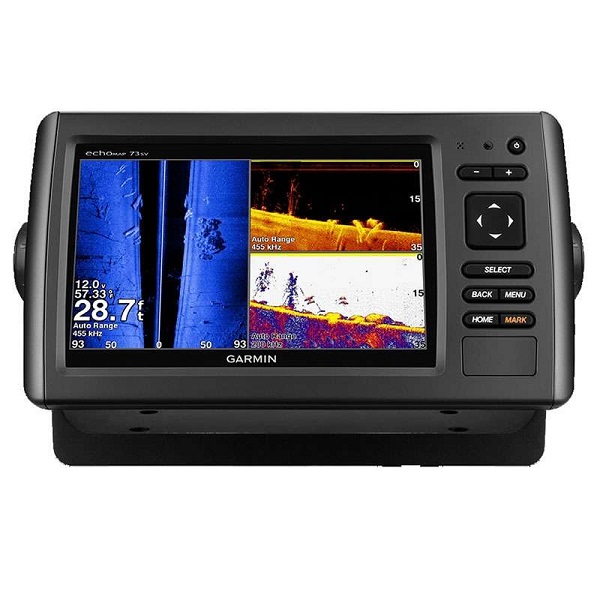 |
|
| Rating | ★★★★★ | ★★★★★ | ★★★★★ |
| Screen | 7″ (800×480) | 7″ (800×480) | 7" (800×480) |
| Sonar | 50/77/200 kHz | 50/77/200kHz | 50/77/200 kHz |
| Chirp | |||
| GPS | |||
| Micro SD | - | - | |
| Price | $$$$ | $$$$ | $$$$ |
| Check on Amazon | Check on Amazon | Check on Amazon |
Garmin Striker 7SV
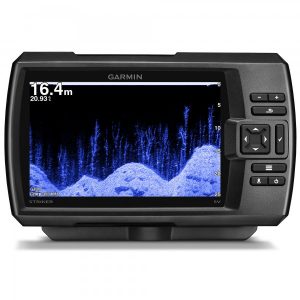
The ultimate standout feature of the Garmin Striker 7SV is its high frequency sonar, which Garmin touts as being able to give near-photographic quality sonar images. Everything in the water from fish to structures are rendered in remarkable detail so you can always find the fish you’re looking for. This accuracy is aided by CHIRP sonar, which further adds detail and accuracy to below-the-surface structures. Additionally, there is a built-in flasher for your ice fishing needs.
The user interface is super simple, featuring keypad operation with dedicated buttons. This allows you to focus on the task at hand without having to toggle between various screens. For ease of navigation, there’s a way-point map, allowing you to easily find and mark underwater structures.
Garmin Striker 7SV Complete Review
Garmin Striker 7Cv
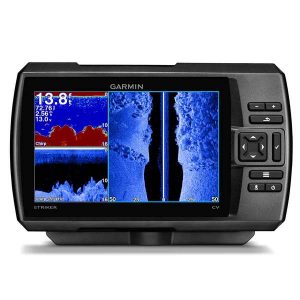
High-frequency sonar with CHIRP sonar technology provides what Garmin calls near-photographic imagines; indeed, the clarity provided by Garmin’s system is remarkable and a force to be reckoned with. The Striker 7Cv features a built-in flasher for classic viewing; also, it comes in various screen sizes all the way up to 7 inches, for greater visibility. A waypoint map and transducer are also included with this model.
Garmin Striker 7CV Complete Review
Garmin Echomap Chirp 73SV

High frequency CHIRP sonar provides Garmin’s well-known high-quality sonar imagery that is definitely among the best of the best in the industry. With 500-watt CHIRP, you get ultimate visibility and target separation. This model comes with an array of built-in US and Canadian HD maps, including US Bluechart G2 charts. Additionally, it comes with a transducer and a best-in-class 5Hz GPS already built-in.
Perhaps the most unique feature is Garmin’s QuickDraw, which allows you to create your own detailed contour maps.
Garmin Echomap Chirp 73SV Complete Review
| Humminbird Helix 10 DI | Humminbird Helix 10 SI | Humminbird HELIX 9 | Raymarine Dragonfly 5 Pro | |
|---|---|---|---|---|
 |
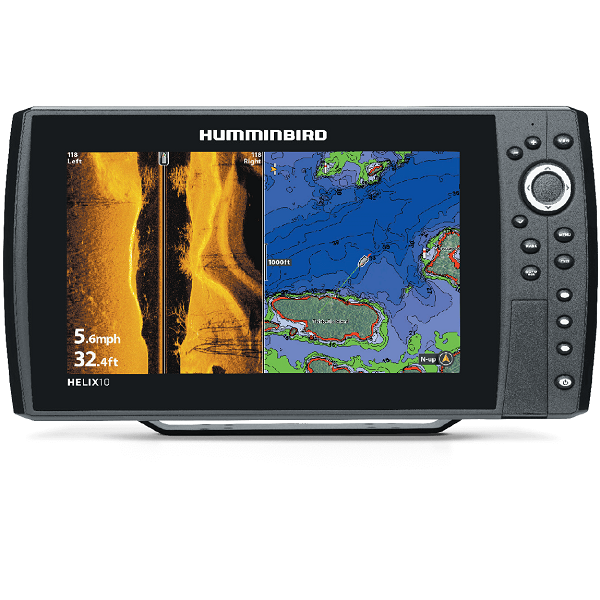 |
 |
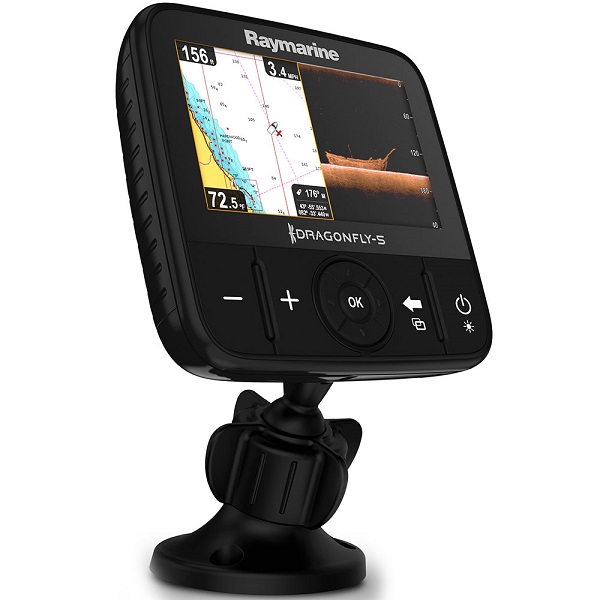 |
|
| Rating | ★★★★★ | ★★★★★ | ★★★★ | ★★★★ |
| Screen | 10.1" (600V x 1024H) | 10.1" (600V x 1024H) | 9" (800H x 480V) | 5" (800 x 480 WVGA) |
| Sonar | 50*/83*/200/455/800 kHz | 200/83/455/800/50* kHz | 50*/200/83/455/800* kHz | 170-230 kHz / 25° |
| Chirp | - | |||
| GPS | ||||
| Micro SD | ||||
| Price | $$$$$ | $$$$$ | $$$$ | $$$ |
| Check on Amazon | Check on Amazon | Check on Amazon | Check on Amazon |
Humminbird HELIX 10 DI

The Humminbird Helix 10 DI features an impressive 10-inch color display with backlit LED for improved contrast and visuals. The fish finder is operated via dedicated buttons, along with three programmable buttons that you can use to access your top features in a flash.
Humminbird Sonar allows for accurate and clear sonar visuals, as well as the ability to identify structures and then map them with Humminbird’s Auto Chart Live feature in real time. HD imagery is possible thanks to HD Down Imaging Sonar with Dual Beam PLUS with Switch Fire, which totals a whopping 4000-watts PTP power output. You also get ethernet capabilities and GPS chart plotting, making for a very robust fish finder.
Humminbird Helix 10 DI Complete Review
Humminbird Helix 10 SI
The Humminbird Helix 10 SI comes with a 10.4-inch wide screen color display with LED backlighting for optimal image clarity and contrast even on days when the sunlight is harsh and bright and would normally be a hindrance to viewing a digital screen. The display allows for dual windows for sonar and contour visuals all at a glance. Sonar images come in crystal clear thanks to Dual Beam Sonar. This model features a pushbutton interface, programmable buttons and comes complete with GPS included. It also comes with a gimbal or optional in-dash mount.
Humminbird Helix 10 SI Complete Review
Humminbird HELIX 9
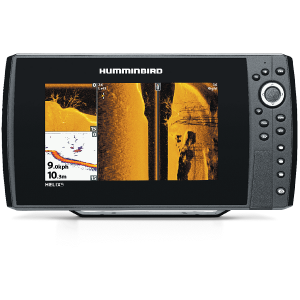
The Helix 9 from Humminbird features a 9-inch LED backlit display, which allows for easy viewing on days when the sun is extremely bright, thanks to an improvement in color and contrast, as well as minimized image distortion. Dual Beam PLUS Sonar with Switch Fire provides for an impressive 4000 watts of PTP power output.
Humminbird ContourXD and ethernet capabilities are built right in for GPS chart plotting. The interface is pushbutton, and you get three programmable buttons along with that which you can use to program your favorite features so they’re always ready to go. This unit can be used with a gimbal or optional in-dash mount. Additionally, it features the ability to be upgraded, which makes it a great choice for those seeking customization.
Humminbird HELIX 9 SI Complete Review
Raymarine Dragonfly-5 Pro
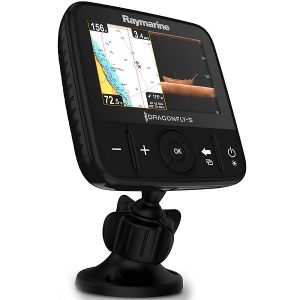
The Raymarine Dragonfly-5 Pro features a backlit LED color display that is easy to read and impervious to internal fogging, so even when the weather is less than ideal, you can still view your sonar images with crystal clarity. The Dragonfly-5 Pro features dual channel sonar. On the one hand, you have CHIRP DownVision sonar for optimal visual clarity, rendering sonar imagery near-photographically; on the other, you have CHIRP conventional sonar that is ideal for finding fish. These two work together to optimize and balance fish finding with surface and object visuals.
The standout feature on this Raymarine offering is easily its ability to synch with the Raymarine Wi-Fish mobile app, which allows you to stream your sonar data straight to your smartphone. Additionally, Wi-Fish allows you to review your sonar images and share them on your favorite social media outlets like Facebook, Twitter, Instagram and more. The included internal storage allows for storing 3,000 waypoints and 15 tracks. For those with more robust storage needs, there’s also a built-in micro SD card reader, which you can use to save any extra data you need.
Raymarine Dragonfly 5 Pro Complete Review
Conclusion
There were a lot of great offerings in this ultimate fish finder roundup, but at the end of the day, the clear winner has to be the Humminbird Helix 10 SI. With its wide HD LED backlit display and robust sonar capabilities, as well as its easy navigation and ability to view multiple screens at once make it a clear and easy choice as the roundup winner.
Best Fish Finder Complete Buying Guide
How Does a Fish Finder Work?
A fish finder works using the sonar technology. A cone-shaped transducer is fixed on the bottom of the boat which emits sound waves. When the sound waves are spread into the water, the device takes note of how long the sound waves take to return to the transducer. A fish finder, thus, works by detecting the reflected sound waves, and these impulses are converted into information that is displayed on the screen of the device. The user gets a graphic display on the screen when the electronic impulses are reflected back from the fish.
A fish finder can also measure the depth of the water and the water bed structure. A fish finder indicates the presence of a fish by showing a fish on the screen or a few fish in the form of small icons. That depends on the type of fish finder.
How to Choose the Best Fish Finder?
People who don’t have technical knowledge regarding fish finders get lost in terms such as sonar technology, frequency, transducer, echoes, and flashers. However, it is necessary to understand the mechanism and have some technical knowledge regarding the product so that you don’t end up buying a useless device for fishing.
Everyone aims to catch the most fish, which is why we will make it easier for the average person to have a little understanding about how to buy a suitable fish finder. The following factors should be considered before buying a fish finder:
Power
The power of the fish finder is one of the most important factors to consider. The power is indicated in watts (W). If the wattage is higher, the fish finder will detect the fish and display the readings faster. A high-powered fish finder is best suited for deep waters and quick detection of fish, while a low-powered device will be suitable for shallow waters only.
The fish finder converts the sonar waves received from the transducer into information, and if the power is not enough, the performance will slow down. Fish finders which have a high power will provide fast detection and clearer reading on the display.
Hence, if you’re planning to fish in saltwater bodies, oceans, or large lakes, you must buy the most powerful fish finder. For example, at 100 watts and 50 kHz, your device will be able to detect fish at a depth of up to 400 feet.
Transducers

A Transducer installed under a boat (Image from boats.com)
A transducer is a unit that sends and receive electronic impulses to detect fish. As explained above, these units emit sonar waves which are bounced back from the objects in the water and received by the transducer again. This data is sent by the transducer to the main unit, which converts this information into an image that is viewable and interpretable by the viewer. Some transducers have a transom mount, which are the easiest to install. The thru-hull transducers are for more advanced boats.
Transducer units come in different materials, and most of them are made of plastic. For casual fishing and sporting, a transducer with a plastic transom mount is ideal as it is compatible with a variety of boats. Plastic housing is recommended for metal or fiberglass hulls, while for steel or aluminum hulls, it is recommended to use steel housing. If the transducer is made up of a wood hull, it is best to use bronze housing.
Frequency
Transducers are available at different frequencies. The frequencies are also a big factor in determining the performance of the device. Transducers mostly come in the frequencies of 50, 83, 192, or 200 kHz and are related to the angle of the cone. For shallow water, the higher frequencies such as 192 and 200 kHz work the best, but if you want to fish in deep waters, the lower frequencies will work. The low-frequency transducers such as 50 or 83 kHz are perfect for professional fishers and commercial users. Now, let us explain how the frequency of this device is an important factor to consider.
Higher frequencies show more details on the screen because more electronic impulses are emitted and received by the transducer. Therefore, for shallow waters, the high frequency is ideal because you can get more detailed and refined images easily. There are some fish finders which offer even more than 400 kHz frequency, which allows the user to have a more generalized view and fine details. At such a high frequency, you can easily get more details and identify even the plants or other objects at the bottom of the sea, while at a low frequency, you will get a fuzzy image.
These days, dual frequency fish finders are available, which allow you to get readings from two frequencies.
Display Size
Fish finders are available in different display sizes. It is obvious that bigger screen sizes will give a better and clearer image as compared to the device which has a small screen. On a big display, you will be able to get more details regarding speed, echoes, numbers, and temperature more easily. Devices with bigger display sizes are also more expensive than the smaller screens.
Screen Resolution
The screen resolution is another big factor in determining the performance of a fish finder. Everyone knows that the greater the number of pixels, the better the screen resolution is. If you want a clearer and crisper image and details of the fish, you must go for a higher screen resolution.
The minimum screen resolution for a fish finder is 240 x 160 pixels and for this specification, the image will be a bit blurry and fuzzy. Let’s explain it to you in another way. Consider one pixel as one dot. If there are more dots, they will combine to give you a better and broader picture of whatever you want to see.
The screen resolution will, thus, determine the clarity of the image you will get. Devices with better screen resolution and larger displays are more expensive, so if you are looking forward to investing in this device and want something professional, you must go for the one that has a good screen resolution.
Cone Angle and Beam
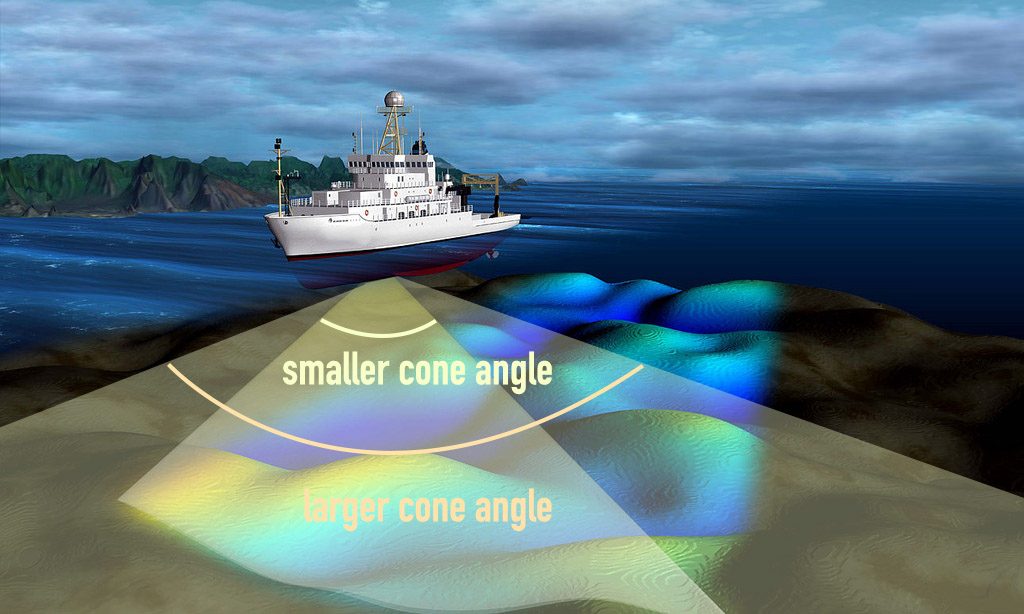 The cone angle of the transducer plays an important role in this device. By cone angle, we mean the width of the beam that is sent from the boat to the water. The transducer is present at the top of the cone where it is thin and pointy. The wider the cone is, the larger the area it will cover. The cone angle gets wider as you go deeper, and the sensitivity also starts getting diminished. Most transducer units have angles lying between 16 and 20 degrees, but they can also have a minimum cone angle of 9 degrees and a maximum cone angle of 60 degrees. With the advancement of technology, we are now getting to see transducers with a dual beam, side beam, and triple beam too. These transducers are ideal for fishing in lakes.
The cone angle of the transducer plays an important role in this device. By cone angle, we mean the width of the beam that is sent from the boat to the water. The transducer is present at the top of the cone where it is thin and pointy. The wider the cone is, the larger the area it will cover. The cone angle gets wider as you go deeper, and the sensitivity also starts getting diminished. Most transducer units have angles lying between 16 and 20 degrees, but they can also have a minimum cone angle of 9 degrees and a maximum cone angle of 60 degrees. With the advancement of technology, we are now getting to see transducers with a dual beam, side beam, and triple beam too. These transducers are ideal for fishing in lakes.
Colored or Black & White Screens
Colored screens are one of the biggest developments electronics had seen in the past. A colored fish finder will present a better picture as it will show millions of colors on the screen. A black and white screen will only present 265 shades, which is not enough to get a clear underwater image. In broad daylight, colored screens are easier to read and interpret as compared to black and white screens. Also, if the weather is cloudy or dark, colored screens will be able to find fish easily because they will allow the user to identify whether it’s a fish or something else.
Black and white models of fish finder are still available and are very cheap too. However, a colored screen fish finder will give you a better fishing experience. If you are tight on budget, you can consider the black and white screen fish finder as it can also do the task and help you find fish at a lower cost.
Downscan Imaging
Downscan imaging is a very useful feature, and it allows the user to catch more fish. This is the most advanced technology and is available in the latest fish finders. When you are in shallow waters, the fish finder will allow you to view everything present below your boat in clear and crisp graphics. With sonar technology, you will be able to see the objects such as plants or fish in the form of dots, but with the downscan imaging technology, you will get the image of the plants or fish exactly as they are. Thus, if you have a good budget and want a professional fish finder, you can consider one with downscan imaging technology.
GPS
The global positioning system is also present in most fish finders these days. This addition to the device helps you to remain safe and secure. You can pinpoint your location using the GPS technology and save it if you want to revisit the spot later. You can add more convenience to your fishing by using different features of the GPS because this technology is very reliable and effective.
Before going to fish in a large sea or lake, you must go with a fish finder that is equipped with GPS. A GPS is very important if you want to keep yourself safe and secure because it will help you remember the routes and prevent you from being lost in the big sea. For safety reasons, we recommend fish finders with two GPS units so that they can use one to explore the underwater structure and the other to map routes.
Side Scan Technology
The side scan technology is another advanced technology used in fish finders these days. This technology gives an enhanced picture of the area. It helps people see anything that is present at the side of the boat. It allows you to cover a large area on the sides of the boat and thus, you can detect anything that’s hiding on the sides. Some fish finders offer around 240 feet coverage on the left and right side of the boat and provide graphical images.
A transducer emits beam only downwards, but the side scan technology allows you to see everything even when the water is dark or dirty. This saves a lot of time, and you can get clear images of plants, fish, and other objects in the water. Having a side scan technology equipped in the fish finder can give you a lot of benefits, and you can have the opportunity of catching more fish.
Conclusion
There are many fish finders available on the market with different features and price tags. To find the best device for your use, you need to do a little research and get a reliable product according to your budget and requirements. Before buying a fish finder, determine your needs based on the comprehensive buying guide provided in this article. Everyone has different fishing styles and needs and thus, it is important to consider these factors before buying a fish finder.
The best fish finder is equipped with all the necessary features that can make your fishing experience better and enjoyable. To get the best quality, you must be ready to invest. However, the cheap fish finders are also efficient enough to meet your basic fish finding needs.

